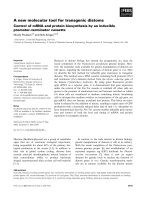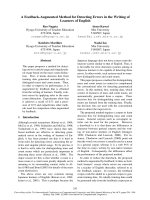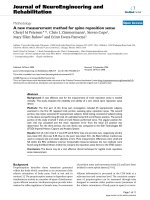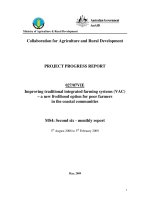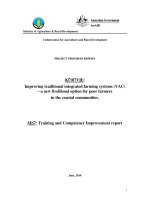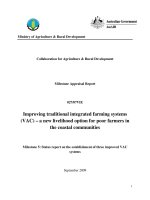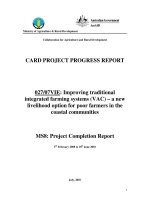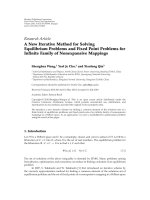A new numerical method for rotating systems in engineering analysis and design
Bạn đang xem bản rút gọn của tài liệu. Xem và tải ngay bản đầy đủ của tài liệu tại đây (2.16 MB, 121 trang )
A NEW NUMERICAL METHOD FOR ROTATING SYSTEMS IN
ENGINEERING ANALYSIS AND DESIGN
SZE PAN PAN
DEPARTMENT OF CIVIL ENGINEERING
NATIONAL UNIVERSITY OF SINGAPORE
2005
A NEW NUMERICAL METHOD FOR ROTATING SYSTEMS IN
ENGINEERING ANALYSIS AND DESIGN
SZE PAN PAN
(B.Eng. (Hons.), NUS)
A THESIS SUBMITTED
FOR THE DEGREE OF MASTER OF ENGINEERING
DEPARTMENT OF CIVIL ENGINEERING
NATIONAL UNIVERSITY OF SINGAPORE
2005
Acknowledgements
I wish to acknowledge the Singapore Millennium Foundation for its M.Eng scholarship
grant that allows me to pursue this research. I am very grateful for the guidance and
support by Prof Koh C.G. throughout this project. Thanks to my colleagues and friends,
who have helped me in one way or another during the course of my study.
i
Table of Contents
ACKNOWLEDGEMENTS i
TABLE OF CONTENTS ii
S
UMMARY iv
N
OMENCLATURE v
LIST OF FIGURES vii
LIST OF TABLES ix
1. INTRODUCTION 1
1.1 General 1
1.2 Literature Review 2
1.2.1 Analytical Methods 3
1.2.2 Numerical Methods 8
1.2.3 Moving Element Methods 8
1.2.4 Disk Model 9
1.3 Objectives and Scope 13
1.4 Layout of Thesis 14
2. METHODOLOGY AND FORMULATION 16
2.1 Formulation of Plate in the Polar Coordinates 16
2.2 Formulation of Moving Element Method 21
2.2.1 Shape Functions for Degenerated Plate Elements 21
2.2.2 Principle of Virtual Work 24
2.2.3 Bending Stiffness 25
2.2.4 Transverse Shear Stiffness 27
2.2.5 Geometric Stiffness 33
2.2.6 Equation of Motion 36
2.3 Time Domain Solution to General Rotating Dynamics 40
3. RESULTS 45
3.1 Convergence Study 45
3.1.1 Element Size Convergence Study 46
3.1.2 Time-step Size Convergence Study 47
3.2 Case 1: Stationary Disk Subjected to Rotating Load (SD-RTL) 49
3.3 Case 2: Rotating Disk Subjected to Stationary Load (RD-STL) 52
3.4 Dynamic Response of Disks 55
3.4.1 In-plane Response 55
3.4.2 Varying Speed 56
3.4.3 Varying Load 57
ii
4. PARAMETRIC STUDIES AND APPLICATIONS 73
4.1 Effect of Membrane Stresses 73
4.2 Effect of Damping 79
4.3 Aerodynamic Effect 81
4.4 Effect of Modulus and Poisson Ratios 82
5. CONCLUSIONS AND RECOMMENDATIONS 97
5.1 Conclusions 97
5.2 Recommendations for Future studies 99
REFERENCES 100
A
PPENDIX 103
iii
Summary
Moving Element Method (MEM), a new method that incorporates moving co-ordinates into the
well-known Finite Element Method (FEM), is a powerful tool in solving dynamics problems of
moving loads. It has been shown earlier to be an elegant method for one-dimensional train-track
problems and subsequently developed for in-plane dynamic problems of rotating disks.
The
method is herein further advanced into more important out-of-plane dynamic problems of
rotating disks in this thesis. The study involves mainly numerical study to examine the
efficiency and accuracy of the results. Dynamic response including displacements,
stresses and strains are studied numerically. Two types of moving load problems,
namely, stationary disk subjected to rotating transverse load (SD-RTL) and rotating disk
subjected to stationary transverse load (RD-STL) are compared. The effects of various
parameters are investigated in the study. They are effects of membrane stresses,
damping, aerodynamic, modulus and Poisson ratios. The advantages of the MEM as a
creative numerical tool in solving rotational dynamics problems are demonstrated.
iv
Nomenclature
Coordinates
(
)
,,rz
θ
Material coordinates
(
)
,,rz
η
Space coordinates
Material
E
Modulus of elasticity of the disk material
υ
Poisson ratio of the disk material
ρ
Density of the disk material
i
r
Inner radius of an annular disk
o
r
Outer radius of an annular disk
h
Thickness of the disk
0
D
Elasticity rigidity,
2
1
E
h
υ
−
D
Flexural rigidity,
3
2
12(1 )
Eh
υ
−
k
Shear correction factor
General
κ
Curvature change of deflection middle plane
σ
Membrane stresses
m
Internal moments per unit length of the middle plane
U
Strain energy
T
Kinetic energy
2
∇
Laplace operator in polar coordinates
t
Time
r
Position vector
v
Velocity vector
a
Acceleration vector
r
u , u
θ
,
z
u
Displacements in
r
−
,
θ
−
and z
−
directions
u
, ,
v w
Displacements in
r
−
,
θ
−
and z
−
directions in the middle plane
r
ε
,
θ
ε
,
r
θ
ε
Radial, tangential and shear strains
0
r
ε
,
0
θ
ε
,
0
r
θ
ε
Radial, tangential and shear strains in the middle plane
r
σ
,
θ
σ
,
r
θ
σ
Radial, tangential and shear stresses
MEM
N
Shape functions for displacements and slopes
w
N , ,
r
N
η
N
Shape functions for ,
w
η
β
and
r
β
respectively
rz
γ
N
Shape functions for evaluation of shear in
rz
−
plane
z
η
γ
N
Shape functions for evaluation of shear in
z
η
−
plane
W
Displacement vector
{
}
1112 2 2 6
T
rr
ww
ηη
ϕϕ ϕϕ ϕ
L
η
v
Elasticity rigidity,
10
10
1
00
2
υ
υ
υ
⎡
⎤
⎢
⎥
⎢
⎥
⎢
⎥
⎢
⎥
−
⎢
⎥
⎣
⎦
0
D
b
D
Bending rigidity,
3
2
10
10
12(1 )
1
00
2
Eh
υ
υ
υ
υ
⎡
⎤
⎢
⎥
⎢
⎥
⎢
⎥
−
⎢
⎥
−
⎢
⎥
⎣
⎦
s
D Shear rigidity,
10
01
2(1 )
kEh
υ
⎡
⎤
⎢
⎥
+
⎣
⎦
b
K
Bending stiffness matrix
s
K
Transverse shear stiffness matrix
G
K
Geometric stiffness matrix
M
Equivalent mass matrix
C
Equivalent damping matrix
K
Stiffness matrix (include ,
b
K
s
K and )
G
K
ζ
Damping coefficient
b
σ
Stress due to bending of plate
b
ε
Stain due to bending of plate
b
B ,
s
B ,
G
B
B matrices for bending, shear and geometric stiffness
nor
P , P
tan
Normal and tangential load acting in the in-plane direction
Ω
, Ω
&
Speed and acceleration of rotation
Ω
Dimensionless rotating speed
4
o
rh
D
ρ
Ω
∗
Ω
Dimensionless rotating speed (in-plane)
o
r
E
ρ
Ω
vi
List of Figures
Fig. 2.1 Model of annular disk subjected to load 42
Fig. 2.2 Mesh of moving elements 43
Fig. 2.3 3 degree-of-freedom at each node 43
Fig. 2.4 A typical element 43
Fig. 2.5 Sampling points for transverse shear 44
Fig. 3.1 Percentage difference with converged value for a stationary
annular disk with various radius ratios subjected to point
transverse load at the outer boundary
58
Fig. 3.2 Time history of displacement for disks of 3 different radius
ratios subjected to uniform transverse pressure
58
Fig. 3.3 Time history of displacement under point load on a disk of
radius ratio 0.5
60
Fig. 3.4 Deflection profile at the outer radius at different times 60
Fig. 3.5 Displacement for a stationary disk subjected to
rotating transverse point load
61
Fig. 3.6 Displacement along outer radius for stationary disk with radius
ratio 0.5 subjected to transverse point load rotating at various
dimensionless speeds
63
Fig. 3.7 Dimensionless critical speeds at various modes for stationary
disks with different radius ratios subjected to rotating transverse
point load
63
Fig. 3.8 Deflection profile for disk with radius ratio 0.5 at various critical
speeds
64
Fig. 3.9 Displacement for a rotating disk subjected to
stationary transverse point load
65
Fig. 3.10 Comparison of displacement under load for the case of
RD-STL and RD-RTL
67
Fig. 3.11 Comparison of displacement profiles in 4 cases: SD-STL, RD-
RTL, SD-RTL and RD-STL at
Ω
=5.24
67
Fig. 3.12 Dimensionless critical speeds for rotating disks with different
radius ratios subjected to stationary transverse point load at
various modes
68
Fig. 3.13 Comparison of results with Adams (1987) 69
Fig. 3.14 Comparison of displacement under load for RD-STL with
different inner boundary conditions: Clamped and Simply
Supported
69
Fig. 3.15 Rotating speed profile for the disk 70
Fig. 3.16 Radial and circumferential displacement profile for the free
rotating disk
70
Fig. 3.17 Transverse displacement profile for rotating disk subjected to
rotating uniform transverse pressure
71
Fig. 3.18 Rotating speed profile for the disk 71
vii
Fig. 3.19 Transverse displacement profile for rotating disk subjected to
point transverse load
71
Fig. 3.20 Transverse displacement for disk subjected to
harmonic load of frequency 60 rad/s
72
Fig. 3.21 Transverse displacement for disk subjected to
harmonic load of frequency 98 rad/s
72
Fig. 4.1
Model of a stationary disk, which is loaded at
30 30
η
°≤ ≤ °
in
the in-plane direction, is subjected to rotating transverse uniform
pressure
85
Fig. 4.2 The radial stress , circumferential stress and shear stress
distributions due to a patch normal compression load =-
7.5E+06Nm
nor
P
-1
acting on
30 30
η
−
°≤ ≤ °
at the outer radius
85
Fig. 4.3 Transverse deflection profile at the outer radius when the disk is
subjected to four different magnitudes of in-plane compression
patch load: 0 Nm
-1
, 2.5E+06 Nm
-1
, 7.55E+06 Nm
-1
and 12.5E+06
Nm
-1
86
Fig. 4.4 Transverse deflection profile at the outer radius when the
individual stresses are ignored: all stresses , no radial stress , no
circumferential stress and no shear stress
86
Fig. 4.5 Displacement for disk subjected to in-plane patch compression
force of three different magnitudes
87
Fig. 4.6 The radial stress, circumferential stress and shear stress
distributions due to a patch normal tensile load
=7.5E+06Nm
nor
P
-1
acting on
30 30
η
−
°≤ ≤ °
at the outer radius
88
Fig. 4.7 Transverse deflection profile at the outer radius when the disk is
subjected to five different magnitudes of in-plane tensile patch
load: 0 Nm
-1
, 2.5E+06 Nm
-1
, 7.55E+06 Nm
-1
, 12.5E+06 Nm
-
1
and 17. 5E+06 Nm
-1
88
Fig. 4.8 Displacement for disk subjected to in-plane patch tensile force of
four different magnitudes
89
Fig. 4.9 The radial stress, circumferential stress and shear stress
distributions due to a patch normal tensile load
P
tan
=7.5E+06Nm
-1
acting on
30 30
η
−
°≤ ≤ °
at the outer radius
90
Fig. 4.10 Displacement for disk subjected to in-plane patch tangential
force of four different magnitudes
91
Fig. 4.11 Dimensionless critical speeds for stationary disk subjected to
uniform in-plane normal loads of various magnitudes at the outer
boundary and rotating transverse point load
92
Fig. 4.12 Dimensionless critical speeds for stationary disk subjected to
uniform in-plane tangential loads of various magnitudes at the
outer boundary and rotating transverse point load
92
Fig. 4.13 Dimensionless critical speeds for rotating disk subjected to
uniform in-plane normal loads of various magnitudes at the outer
boundary and stationary transverse point load
93
viii
Fig. 4.14 Magnification of circumferential displacement for rotating disks
of different radius ratios subjected to uniform tangential load at
outer boundary
93
Fig. 4.15 Magnification of displacment under point load for disk with
different damping coefficient
94
Fig. 4.16 Dimensionless critical speeds for rotating disk with elastic
foundation
of different stiffnss
94
Fig. 4.17 Dimensionless critical speeds for stationary disks with different
modulus ratios subjected to rotating transverse point load at
various modes
95
Fig. 4.18 Dimensionless critical speeds for rotating disks with different
modulus ratios subjected to stationary transverse point load at
various modes
95
Fig. 4.19 Dimensionless critical speeds for rotating disks with modulus
ratio 4.0 and different Poisson ratios subjected to stationary
transverse point load
96
ix
List of Tables
Table 3.1 Parameters used in the study 46
Table 4.1 Displacement along outer radius using different damping
coefficient
80
Table 4.2 Magnification of displacement for disks with different modulus
ratios
84
x
1 Introduction
This thesis aims to study dynamic problems of rotating disks using Moving Element
Method (MEM). The applications of rotating disks in the industry and the importance of
this study are introduced in this chapter. A literature review would be presented on past
analytical and numerical studies for problems that involve rotating disks and moving load.
The recent development of MEM would be described. Moreover, various possible disk
models are looked into and the most suited one is chosen. The objectives and scope of
this study are defined. Finally, the content of the subsequent chapters are introduced at
the end of this chapter.
1.1 General
Rotating disks can be found readily in vehicle wheels, automotive disk brakes, circular
saw blades and computer memory disks. There is demand on increasing rotating speeds.
Trains are to travel faster, faster circular saws imply higher productivity and higher
rotating speed allow higher data access rates in disk drives. The dynamic behavior of the
rotating systems needs to be studied accurately and account for the effects of high
rotating speeds.
1.2 Literature Review
Abundant literatures related to disk problems can be found over the years. The motives
behind all the disk-related problems are their industrial applications like circular saw
1
blades, computer memory disks and disc brakes. It is noticed that many of these
applications involve a rotating annular disk subjected to stationary load. In circular saw
blade, as the blade rotates to cut an object, in-plane and transverse forces is exerted to the
blade at the contact. For a floppy-disk drive, read/write head exerts transverse load to the
disk. In the case of hard-disk drive, the aerodynamic interaction between the read/write
heads and disks gives rise to transverse force on the hard disk. On braking, a patch
transverse load is applied at top and bottom of the rotating disc brake.
In addition to loading, there are different concerns for these applications. For circular
saw blades, the initial stresses due to rolling and the temperature distribution and the
loading at the edge of the disk would be the main concerns. For data storage disk, the
membrane stresses are significant due to the high rotating speed. The effect of air flow
and heat from the motor or induced by air friction can affect the response of disk greatly.
Finally, the effects of friction force and high temperature induced due to the braking
force are important for disc brakes. Nevertheless, as the rotating speed is relatively low
in the disc brake, the problem is often simplified as a stationary disk subjected to rotating
load. Various analytical solutions have been proposed over the years. However, they are
often restricted. Numerical methods are proposed in recent decades to look into problems
that are too complicated to be solved analytically, for instance, polar orthotropic disk,
disk with varying thickness and disk rotating at varying speeds. Numerical methods
using FEM may be inefficient in solving problems that involve relative motions.
Recently, a new method called the Moving Element Method (MEM) has been proposed
2
to improve FEM in solving 1-D moving load problems and can be extended to solve the
abovementioned disk problems.
1.2.1 Analytical Method
Disk dynamics in both in-plane and transverse (out-of-plane) directions has been studied.
In-Plane Responses
Two cases in the in-plane response have been studied: stationary disk subjected to
rotating load and rotating disk subjected to stationary load. In both cases, relative motion
between the disk and the load is involved. The latter case is different from the former not
only in the addition of centrifugal force but also Coriolis effect. Therefore, it is only a
good approximation for former case of disk rotating at very low speeds. Srinivasan and
Ramamurti (1980) studied the dynamic response of stationary annular disk subjected to a
moving concentrated, in-plane edge load. Chen and Jhu (1996) applied Bessel function
in studying the case of rotating disk subjected to stationary in-plane load. Coordinate
transformation is applied in both analyses. While Chen has only used linear strain
relationship in predicting disk response and the existence of divergence instabilities and
critical speeds, Moreshwar and Mote (2003) pointed out the stiffening of the rotating disk
under rotation, and thus nonlinear strain, has to be considered at high rotating speeds.
Transverse Responses
For disk in the transverse direction, Kirchhoff plate theory has often been used as it is
suitable for relatively stiff rotating disks like circular saws and computer hard disk. For
3
more flexible disk like computer floppy disk, von Karman plate theory would be more
suitable. The analytical solutions are often used to solve for vibration and stability of the
rotating disk in the transverse direction. Some studies, for example, by Mote (1965) and
Shen and Song (1996) would also attempt to include other effects, such as temperature,
initial stresses, friction force and aerodynamic, for the rotating disk studied. The general
interests lie mainly in finding ways to increase the critical speeds and expand the stability
region. For instance, a higher rotating speed in circular saw blades would imply a higher
production in wood-cutting industry and in disk storage a shorter data access time.
In the classical plate theory as adopted by most analytical solutions, in-plane membrane
forces of rotation are assumed to be unaffected by transverse motion of the plate. The in-
plane and transverse solutions are uncoupled and equilibrium equations can be solved
independently. As a result, the study of disk in the transverse direction involves the
solution of one governing equation as follows:
p
r
w
q
r
w
q
r
r
w
q
r
w
qr
rr
wD
ww
t
w
t
w
h
r
rr
=
⎟
⎠
⎞
⎜
⎝
⎛
∂
∂
+
∂
∂
∂
∂
−
⎥
⎦
⎤
⎢
⎣
⎡
⎟
⎠
⎞
⎜
⎝
⎛
∂
∂
+
∂
∂
∂
∂
−∇+
⎟
⎟
⎠
⎞
⎜
⎜
⎝
⎛
∂
∂
Ω+
∂
∂
Ω+
∂∂
∂
Ω+
∂
∂
θθ
θ
θθ
θθ
θ
θ
ρ
4
2
2
2
2
2
2
2
&
(1.1)
In-plane stress results (3
rd
and 4
th
term on the left hand side of the above equation) are
incorporated in the study merely as initial stresses. Many analytical studies only concern
about axisymmetrical cases and uniform rotating speeds. If in-plane stresses are only due
to centrifugal forces, the shear stresses would be absent. Equation (1.1) is further
simplified. It should be noted that for cases of stationary disk subjected to moving
transverse load, all membrane stresses would be absent. The second term on the left
4
comes from plate bending while the first term expresses the relative motion between load
and disk. In most studies, the annular disks are clamped at inner boundary and free at
outer.
SD-RTL
Several early studies have been conducted for the case of stationary disk subjected to
rotating transverse load. Mote (1970) studied the stability of circular plate subjected to
moving loads. Weisensel and Schlack (1988) studied the forced response of annular plate
due to moving concentrated transverse load of harmonically varying amplitude. Fourier-
Bessel series is utilized. They also observed the critical velocities. They later (1993)
extended to study to include radially moving loads. They have made the assumption that
the centrifugal membrane effect is small relative to the bending effects in the range of
rotating speeds studied. Fourier-Bessel series is used to express the forced deflection
response due to arbitrarily moving concentrated load. Damping and loading parameters
are also studied.
5
RD-STL
While the above literatures assume that the stiffening effect due to centrifugal force in
rotating disk is absent, there are numerous literatures that consider the membrane stresses.
Benson and Bogy (1978) studied the steady deflection of rotating disk due to stationary
transverse load. Various stiffness parameter and load location were studied and shown
graphically. The effects like aerodynamic, in-plane stresses, temperature, friction forces,
material damping and the load parameters on the rotating disk have found to play
important roles and have been observed.
Aerodynamic
Adams (1987) obtained the critical speeds at which a spinning disk is unable to support
arbitrary spatially fixed transverse loads. He included a foundation parameter, which
serves to account for the negative pressure due to the flow out of air at the disk-to-
baseplate air gap, in the governing equation. It has relevance to the floppy disk. With a
smaller disk-to-baseplate gap, stiffness increases and thus critical speed increases as well.
Renshaw (1998) also observed the critical speeds for floppy disks by adding a term
consists of the hydrodynamic coupling strength and the difference of air pressure below
and above the disk into the equation. The pressure variations in the air films are modeled
separately using incompressible Reynolds’ equation. It was found that the critical speed
is 3 to 10 times higher than that in the absence of hydrodynamic coupling. Other
aerodynamic models were suggested by Renshaw et al (1994) and Kim et al (2000).
They both accounted the effect of aerodynamic effect as viscous damping term. It also
involved the determination of certain parameters from the experiments.
6
In-plane Stresses
Shen and Song (1996) extended the study to transverse response of spinning disk
subjected to stationary, in-plane, concentrated edge load. It was found that the
asymmetric membrane stress (in this case involves also the shear stresses in addition to
the radial and circumferential stresses) field resulting from the stationary edge loads
could excite a rotating circular plate transversely.
Temperature
Mote (1965) examined the effect of rotational, thermal and purposely induced in-plane
stresses on the disk with the application of circular saw in mind. As the effect considered
involves only in the in-plane direction, the task involves merely the accurate
determination of radial and circumferential stresses in Equation (1.1).
Friction Forces
Ono et al (1991) later studied a spinning disk when constant friction force, spring and
damper suspension system and damping by air are represented. Their effects on the
stability of the disk are studied.
Material Damping
Kim et al (2000) highlighted that the aluminum substrate in the hard disk has significant
material damping and has to be modeled. A damping term assumed to be proportional to
the rate of bending strain is added to Equation (1.1).
7
1.2.2 Numerical Method
In the last decade, several papers employing numerical methods in the study of rotating
disks can be found. While analytical solution only deals with homogeneous disk with
uniform thickness and case of uniform speed, the numerical method is more flexible.
Chen and Ren (1998) used an annular finite element to study for annular plates with
variable thickness. Chung et al (2000) studied the disk based on the Kirchhoff plate
theory and von Karman strain theory (nonlinear). Employing numerical time integration
method, the case of non-uniform speed was studied. Instead of using plate elements,
Chorng et al (2000) employed solid elements for simple freely rotating disks in order to
take into account for all the initial stresses induced and all the three velocity components.
Son
et al (2000) applies FEM for rotating anisotropic plates subjected to transverse loads
and heat sources based on Mindlin plate theory and the von Karman strain expression.
Liang
et al (2002) studied the response for rotating polar orthotropic annular disks
subjected to stationary load. They found that system with higher value of modulus ratio
or lower Poisson ratio has better stability.
1.2.3 Moving Element Method
As mentioned earlier, the FEM may not be efficient in solving problems involving
relative motion between the disk and the load. Olsson (1991) demonstrated the use of
FEM to a fundamental 1-D moving load problem. As the load is a function of time (its
position changes with time), the dynamic solution of a simply supported beam subjected
to a constant force moving at a constant speed by FEM was achieved by running the
computation over numerous time steps. Nevertheless, as the load moves along the object,
8
keeping track of the load location and updating of the load vector become a cumbersome
necessity. Furthermore, the infinite domain (rail) has to be truncated in the FE model. It
is only a matter of time that the load would be out of the truncated model rendering the
solution invalid. Thus the FE model tends to be very large and only the solution in the
“middle” portion is considered. To this end, Koh
et al (2003) proposed a new method
called the moving element method (MEM) and showed its advantages over the FEM in
solving 1-D moving load problems. The fundamental idea behind the MEM is that
moving elements are conceptual elements which “flow” in the solid object (rail) rather
than physical elements attached to the object. The same idea can be applied to solve the
rotating disk problems as demonstrated by Deng (2002) and Sze (2003) in their study of
in-plane response of disk subjected to rotating load.
1.2.4 Disk Model
In formulating a numerical program for disk problem, an appropriate element has to be
chosen and correct assumptions have to be made.
Solid elements were chosen by Chorng et al (2000). They would be able to provide the
completeness of solution in taking into account of all the initial stresses and all the
velocity components when there are degrees-of-freedom of displacements in all three
directions. As this may be good for simple study of freely spinning disks in their study, it
may not be a wise choice for the study for disk subjected to transverse load, which
involves bending. Also, from the results presented by the author, the improvement in
9
incorporating all the stresses and velocity components is important only for very thick
disks. Thus, plate elements are chosen over solid elements in our study.
There are numerous methods in modeling plates as any finite element text book on plates
like Zienkiewicz and Taylor (1991) show. These are Kirchhoff plate, Discrete Kirchhoff
plate and Mindlin plate. We would assess the merits of these plates and its suitability in
our problem.
Kirchhoff plate
The plate is assumed to be thin and shear in the transverse direction is neglected in
Kirchhoff plate. Almost all the analytical solutions reviewed have employed this plate as
the disks used in popular applications are thin disks. While the implementation in
analytical method is simple, it is not so numerically. For this plate, the only primary
variable is
w. In problems of plate bending, a C1 continuity is required, which is very
difficult to achieve. Thus, there were attempts to ignore the slope continuity and derived
the non-conforming elements. A 4-node (12 DOFs) rectangular element would seem to
be suitable for our study. The shape function transverse displacement,
w, is written as a
cubic polynomial. The slope,
x
θ
and
y
θ
(in our case,
r
θ
and
η
θ
) are the result of
x
w
∂
∂
and
y
w
∂
∂
. The variation of slopes are cubic as well. With cubic polynomial, the additional
term due to MEM,
2
2
η
∂
∂ w
, can be used without adding one more node in the
circumferential direction.
10
Discrete Kirchhoff plate
This plate is similar to Kirchhoff plate, however, the thin plate conditions (i.e.
x
w
x
∂
∂
=
θ
)
are imposed at discrete points along the edges of the elements. The shortcomings of this
method is that it is complicated to apply and not very reliable.
Mindlin plate
This plate element is the most popular in FEM study. Although it is adopted mostly for
thick plates, it can be used for thin plates if the locking phenomenon is mitigated. We
immediately identify the similarity between this element and that is used for our study in
the in-plane direction previously by Sze (2003). As the stress results from the in-plane
would be used as shown in Equation (1.1), the same elements (6 node but with 3 DOF per
node) used for the transverse study would facilitate the implementation.
However, the problem of shear locking has to be tackled as the disk studied is thin. There
are basically three ways of reducing shear locking, namely, reduced integration,
consistent interpolation and assumed strain field. Reduced integration is flexible and
fairly easy to apply. However, there may be spurious zero modes if insufficient gauss
points are chosen. In consistent interpolation method, the shape function for slope is
developed at one degree lower than that for transverse displacement. The shortcoming is
that expensive matrix condensation has to be performed. Assumed strain field method,
suggested by Huang (1989) is the best method among the three. Shear strain has a shape
function one degree lower than displacement and slope. The difficulties, however, would
11
be deriving the correct sample points for shear strain as the 6-node element used is not
conventional.
After comparing the three elements, Mindlin plate with assumed strain field would be
adopted for its ease in implementation and reliability.
12
1.3 Objectives and Scope
This thesis aims to develop an accurate and efficient methodology for the dynamic
analysis of disk subjected to transverse load with relative motion using MEM. A
program written in Fortran 90 is developed to accommodate the new proposed method
and allow flexibility in studying different parameters. The two main cases studied are
Stationary Disk subjected to Rotating Transverse Load (SD-RTL) and Rotating Disk
subjected to Stationary Transverse Load (RD-STL). The effect of the relative motion is
examined. The previous result of disk in the in-plane direction by Sze (2003) is used to
study the effect of membrane stresses on transverse behavior.
The advantages of MEM in solving problem, that involves relative motion, over
traditional FEM are demonstrated. It also offers more flexibility than analytical method
as various considerations can be added in the formulation with ease. With these
advantages, the proposed MEM has tremendous application potential to the engineering
design and analysis of rotating disks.
The disks used in this study are of uniform thickness and elastic. As plate theory is
assumed, the transverse strain is absent. This is a valid approximation as the disk used is
of small thickness. It is thin such that plane stress conditions can be assumed. The in-
plane and transverse directions are uncoupled. The in-plane response only affects the
transverse in terms of membrane stresses. This is also a valid assumption for thin plates.
The deflection of the plate is of magnitude smaller than the disk thickness, thus
transverse behavior does not induce effect to the in-plane behavior.
13
